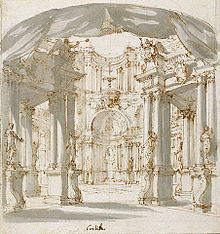Tito e Berenice

Tito e Berenice is an opera (De vita Caesarum.
Background and performance history
Tito e Berenice was the result of a competition set by
maestro di cappella to Prince Ruspoli, was chosen as the composer. The Quirini chose Antonio Salvi to write the libretto for their opera, Lucio Papirio (based on the life of Lucius Papirius), and Francesco Gasparini to compose the music.[3]

According to a French correspondent at the time, Ottoboni "interfered" considerably in the writing process of the libretto for Tito and Berenice, making numerous modifications. Although only Capece's name appears on the printed libretto published by Bernabò for the 1714 premiere, some sources credit Ottoboni as a co-author.castrati, Benedetto Baldassari and Domenico Tempesti.
The French correspondent wrote that the opera had considerably less success with the audiences than Lucio Papirio which premiered two weeks later but that the best opera presented that season was actually
Venetian opera of the day which obligatorily included comic characters no matter how serious or tragic the story. The second was the close collaboration and interplay between the librettist, composer, and set designer in developing each opera. The third was Juvarra's approach to the set designs. Rather than focusing on spectacular special effects and stage machinery for their own sake, his sets were specifically designed to reflect and enhance the action taking place within them.[12]

Roles
| Role | Voice type | Premiere cast, 10 January 1714[13] |
|---|---|---|
| Vespasiano (Vespasian), Emperor of Rome | tenor | Francesco Gucciardi |
| Tito (Titus), Vespasian's elder son | contralto castrato | Domenico Tempesti |
| Domiziano (Domitian), Tito's younger brother | soprano castrato | Matteo Berselli |
| Berenice, (Berenice), Queen of Idumea and the lover of Tito | soprano castrato travesti | Benedetto Baldassari |
| Domizia (Domitia), a Roman noblewoman | soprano castrato travesti | Giovanni Maria Morosi |
| Antiocco (Antiochus, King of Commagene), Tito's friend | soprano castrato | Francesco Natali |
| Fulvio (Fulvius), a Roman courtier | bass | Giuseppe Ignazio Ferrari |
| Cirene, handmaiden to Berenice | soprano castrato travesti | Luigi Sorè |
| Roman soldiers, people of Rome | ||
References
Notes
- ^ Strohm 1997, p. 44; Franchi & Sartori 1997, p. 102
- ^ Lanfranchi, Ariella (1975). "Capece (Capeci), Carlo Sigismondo". Dizionario Biografico degli Italiani, Vol. 18. Treccani. Online version retrieved 13 January 2014 (in Italian).
- ^ Strohm 1997, pp. 44–45.
- ^ Assunto 1989, p. 156; Casaglia 2005
- ^ Strohm 1997, p. 46; Franchi & Sartori 1997, p. 102
- ^ Capece 1714, pp. 5–6.
- ^ Casaglia 2005; Capece 1714, p. 4
- ^ Ferrero 2002, p. 3.
- ^ Franchi & Sartori 1997, p. 103.
- ^ Strohm 1997, p. 46.
- ^ Lucio Papirio received a further performance in Florence in 1716. There is no record of further performances of Tito e Berenice.
- ^ Ferrero 2002, pp. 63–64.
- ^ Premiere cast sourced from Capece 1714, p. 3
Sources
- Assunto, Rosario; et al. (1989). Il Teatro a Roma nel Settecento (in Italian). Vol. 1. Istituto della Enciclopedia italiana.
- Capece, Carlo Sigismondo (1714). Tito e Berenice, dramma per musica (in Italian). Rocco Bernabò.
- Casaglia, Gherardo (2005). "Tito e Berenice, 10 January 1714". L'Almanacco di Gherardo Casaglia (in Italian).
- Ferrero, Mercedes Viale (2002). "Stage and Set". In Lorenzo Bianconi; Giorgio Pestelli (eds.). Opera on Stage. University of Chicago Press. pp. 1–124. ISBN 0226045919.
- Franchi, Saverio; Sartori, Orietta (1997). Drammaturgia romana (in Italian). Vol. 2. Edizioni di Storia e Letteratura. ISBN 8887114064.
- Strohm, Reinhard (1997). Dramma Per Musica: Italian Opera Seria of the Eighteenth Century. Yale University Press. ISBN 0300064543.
